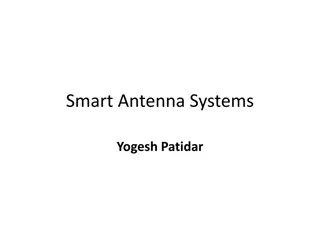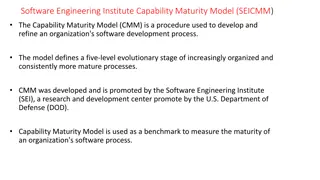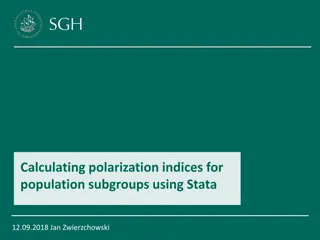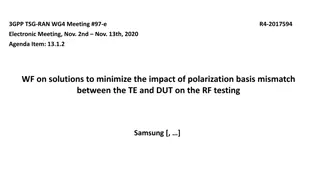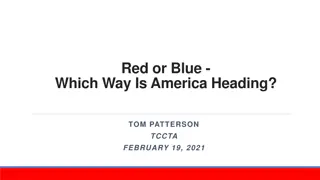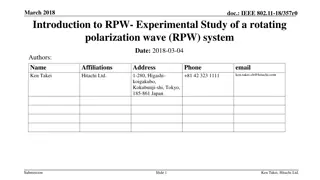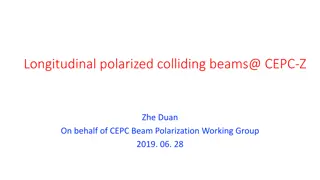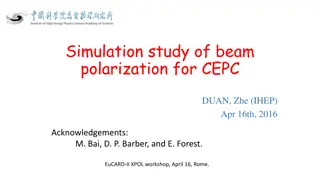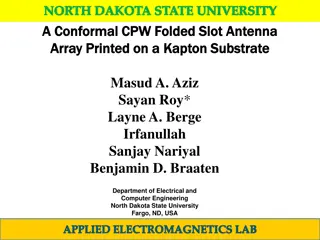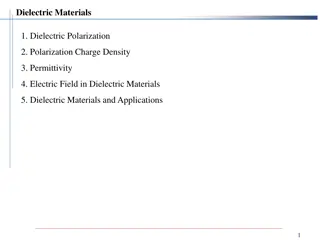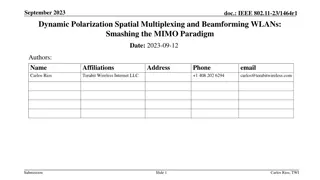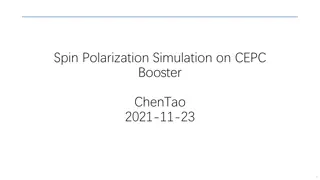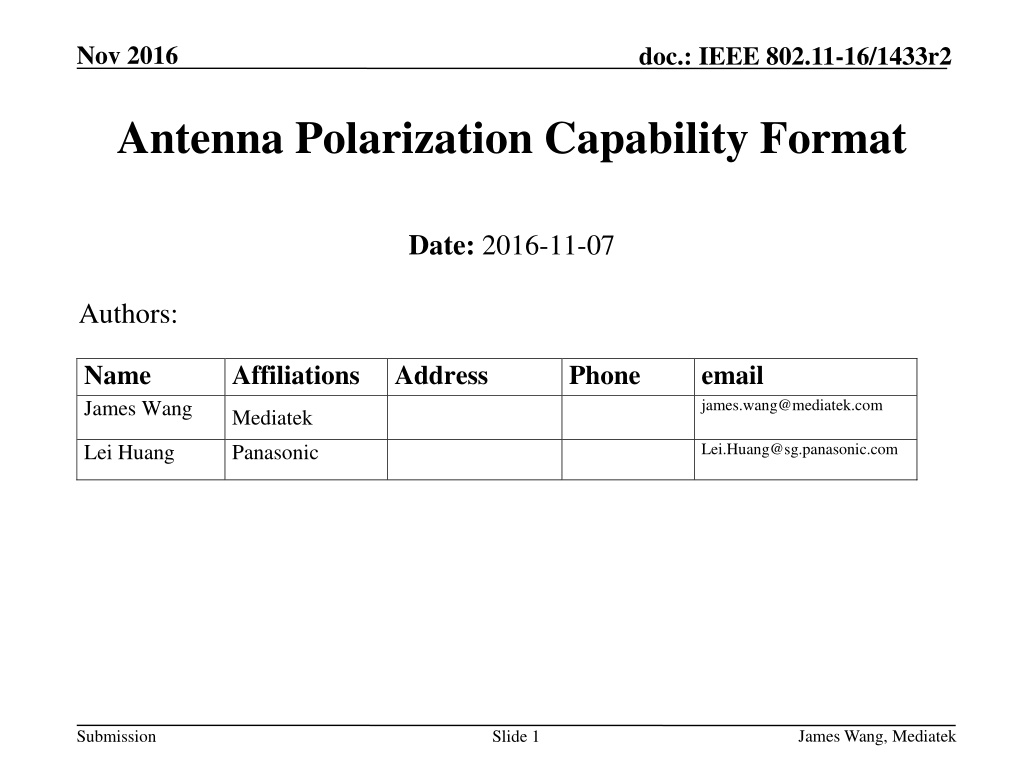
Understanding Antenna Polarization Types and Implementations
Explore the significance of antenna polarization in enhancing performance for small devices with limited space, focusing on linear, circular, and mixed polarizations. Learn about different types of antenna polarization configurations and capabilities, including single polarization, polarization switch, synthesizable polarization, and polarization MIMO.
Download Presentation

Please find below an Image/Link to download the presentation.
The content on the website is provided AS IS for your information and personal use only. It may not be sold, licensed, or shared on other websites without obtaining consent from the author. Download presentation by click this link. If you encounter any issues during the download, it is possible that the publisher has removed the file from their server.
E N D
Presentation Transcript
Nov 2016 doc.: IEEE 802.11-16/1433r2 Antenna Polarization Capability Format Date: 2016-11-07 Authors: Name James Wang Affiliations Address Phone email james.wang@mediatek.com Mediatek Panasonic Lei.Huang@sg.panasonic.com Lei Huang James Wang, Mediatek Submission Slide 1
Nov 2016 doc.: IEEE 802.11-16/1433r2 Introduction Multiple antenna polarizations is an attractive way for small devices with limited space to realize diversity and MIMO Due to propagation characteristics of mmWave, antenna polarization can affect the performance significantly if polarization is misaligned, it affecting end-to-end performance significantly (i.e., signal drops due to polarization misalignment, cross-polarization interference rises) Antenna polarization can support MIMO spatial multiplexing. Intel IEEE 802.11-15/1145r0 SU-MIMO Configurations for IEEE 802.11ay illustrates multiple antenna configurations for SU-MIMO. Several of them relies on antenna polarization. 11ay should adopt more powerful and efficient method to deal with the effects of polarization for ensuring reliable performance IEEE Motion 5/2016 antenna polarization capability information in the 11ay capability exchange. (Capability information is TBD) The current proposal provides the capability format James Wang, Mediatek Submission 2
Nov 2016 doc.: IEEE 802.11-16/1433r2 Basic Types of Antenna Polarization Types of antenna polarization Linear polarization Circular (elliptical) polarization Mixed polarization (difficult to classify) There are three possible orthogonal polarizations (e.g, x, y, z directions) In general, the polarization direction is described by unit vector or euler angle ( , , ) relative to a coordinate system Depending on antenna axial ratio, orientation, and propagation, the cross-polarization alignment loss (provided in backup charts) can be significant. i James Wang, Mediatek Submission 3
Nov 2016 doc.: IEEE 802.11-16/1433r2 Polarization Implementations Two types of polarization implementation Separate antennas for different polarizations (e.g., one antenna vertical, one antenna horizontal) Same antenna with multiple polarizations (e.g., one physical antenna with multiple polarization ports) In general, the former type can be treated as separate antennas The latter type can also be used to synthesize different antenna polarizations: Polarization rotation (i.e. to change angle of inclination for TX/RX polarization alignment) Linear to circular polarization conversion or vice versa The latter type can be used for polarization MIMO, which means that >1 spatial streams are transmitted or received on dual polarizations of the same physical antenna [IEEE 802.11-15/1145r0 SU-MIMO Configurations for IEEE 802.11ay, Intel] Inclined Linear ( 1= 2 G1/G2) or Circular ( 1= 2 +/-90 deg, G1=G2) 1 G1 2 G2 James Wang, Mediatek Submission 4
Nov 2016 doc.: IEEE 802.11-16/1433r2 Polarization Type/Capability Antenna polarization capability information to be considered (Polarization Configuration) Single Polarization Polarization Switch Synthesizable Polarization MIMO Dual Polarization Each polarization configuration above can be one of the following types: Linear Circular mixed polarization (difficult to classify as linear or circular) James Wang, Mediatek Submission 5
Nov 2016 Proposed Antenna Polarization Capability Field doc.: IEEE 802.11-16/1433r2 The Antenna Polarization Capability field is defined Number of DMG Antennas Polarization Capability 1 Polarization Capability N Octets: 1 2 2 The Number of DMG Antennas subfield defines the combined total number of antennas of an EDMG STA. The number of Polarization Capability subfields are equal to the value indicated in the Number of DMG Antenna subfield. James Wang, Mediatek Submission Slide 6
Nov 2016 Proposed Polarization Capability subfield format The Polarization Capability subfield is defined below B0 B1 B2 B3 doc.: IEEE 802.11-16/1433r2 B4 B10 B11- B15 TX/RX Polarization Configuration Polarization Description Reserved Bits: 2 2 7 5 The TX/RX subfield is set to 1 to indicate the antenna is for both transmission and reception, is set to 2 to indicate the antenna is for for transmission, and is set to 3 to indicate the antenna is for reception only. The value 0 is reserved. The Polarization Configuration subfield is set to 0 to indicate Single Polarization, is set to 1 to indicate Polarization switch, is set to 2 to indicate Synthesizable Polarization, and is set to 3 to indicate MIMO Dual Polarization. James Wang, Mediatek Submission Slide 7
Nov 2016 doc.: IEEE 802.11-16/1433r2 Polarization Description If the value of the Polarization Configuration subfield is Single Polarization, or MIMO Dual Polarization, the Polarization Description is set to 0 to indicate linear polarization, is set to 1 to indicate circular polarization, and is set to 2 for mixed polarization. The values 3 to 127 are reserved. B4 B10 Polarization Description 7 If the value of the Polarization Configuration subfield is Synthesizable Polarization, the Polarization Description is set to 0 to indicate linear polarization, is set to 1 to indicate circular polarization, is set to 2 to indicate mixed polarization, and is set to 3 to indicate support of both linear and circular. The values 4 to 127 are reserved. James Wang, Mediatek Submission Slide 8
Nov 2016 doc.: IEEE 802.11-16/1433r2 Polarization Description If the value of the Polarization Configuration subfield is Polarization Switch, the Polarization Description subfield contains 4 subfields. The Number of Throws subfield is set to 0 to indicate 2 throws and is set to 1 to indicate 3 throws. Each of the Throw 1 Polarization subfield, the Throw 2 Polarization subfield, or the Throw 3 Polarization subfield is set to set to 0 to indicate linear polarization, is set to 1 to indicate circular polarization, and is set to 2 for mixed polarization. The value 3 is reserved. If the antenna polarization switch has only 2 throws, the Throw 3 Polarization subfield is reserved. B4 B5 B6 B7 B8 B9 B10 Number of Throws Throw 1 Polarization Throw 2 Polarization Throw 3 Polarization 1 2 2 2 James Wang, Mediatek Submission Slide 9
Nov 2016 doc.: IEEE 802.11-16/1433r2 Straw Poll Do you agree to add the format of Antenna Polarization Capability Field as defined in slides 6 -9 into the 11ay SFD? James Wang, Mediatek Submission Slide 10

